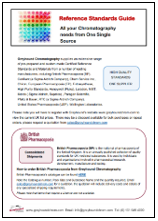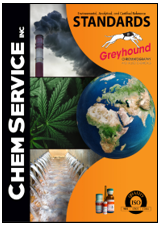HPLC Management in the Laboratory

Today’s High Tech laboratory environment demands the best results, achieved using the latest safety and production solutions. Combined with the best consumables and equipment HPLC is a powerful tool in analysis, a must for today’s results driven, cost conscious laboratory.
Whatever HPLC/UHPLC method is used in the laboratory, choosing the right solvents, safety handling equipment and filtration method is a very important factor to consider when working to achieve the best analytical results. Greyhound Chromatography, experts in the field of Chromatography supply, are delighted to represent the most valued manufacturers of HPLC Products, AIT France; Solvent Safety Caps, Biosolve; Solvents and Formulations for HPLC/UHPLC/Mass Spectrometry/SFC Solvents for Gas Chromatography/ Reference Standard Solvents for Gas Chromatography and Greyhound Chromatography's Q-Fil Syringe Filters and Filter Membranes.
AIT Smart Waste Caps reduce harmful substance emissions from waste bottles by up to 95% and are available to fit a wide range of waste bottle sizes, including drums, either directly or through the use of a suitable adapter. They allow waste solvents from an HPLC to enter the waste bottle but prevent solvent vapours from escaping into the laboratory, by use of an activated charcoal filter cartridge. Smart Waste Caps are available to fit waste solvent containers with a wide range of threads as well as barrels of up to 200 liters in size, (custom manufacturing for other applications is available on request).
|
AIT Smart Healthy Caps:
|
 |
 |
Smart Healthy Caps are designed to comply with the increasing safety regulations of the modern laboratory and are manufactured from inert, chemically resistant materials, such as PTFE and polypropylene.
The use of Smart Healthy Caps can reduce harmful solvent evaporation from solvent inlet reservoirs by up to 80%, protecting health and keeping the HPLC eluent concentration accurate for several days. This is achieved by the use of a one-way check valve which allows air to enter the bottle for pressure equalization, but eliminates solvent vapour emissions.
Smart Healthy Caps also protect solvents against external contamination and are available to fit a wide range of bottle types and sizes. They can be supplied with 1 to 5 outlet ports to accommodate multiple HPLCs. Tubing (1/ 8˝ or 1/ 16˝ od.) is securely fixed with use of the AIT universal fitting which requires no ferrule or flanging of the tube.
Biosolve products are manufactured under strict and detailed operating procedures. The manufacturing plants meet the latest environmental and quality ISO standards, serving as the development, production and distribution centers. From the initial acceptance of selected raw material through process control to the final packed product, all steps are accurately documented. This ensures a high quality of production with lot-to-lot reproducibility and complete traceability for all purposes. Thanks to continual research and development, Biosolve offer one of the finest grade Acetonitrile for HPLC & UHPLC available worldwide: The Supra-gradient grade and the highest brand ULC/MS grade. Manufacturing and recommended expiry dates are clearly stated on the label whenever relevant. Thanks to the strict policy of quality control, Biosolve are an approved vendor to large health organizations, leading pharmaceutical companies and for the chemical and electronic industries.
|
Biosolve Solvent Grades:
|
 |
Biosolve Acetonitrile HPLC-R Brochure
Biosolve ULC/MS CC/SFC Acetonitrile Solvents Catalogue
Biosolve Organic Trace Analyses Brochure
All of the above brochures contains product details of products from Bioslove. If you have any questions about Biosolve products or wish to discuss the pricing and delivery of products from this manufacturer, or any of the many other Manufacturers we represent, please do not hesitate to contact us either by email Sales@greyhoundchrom.com or rachel@greyhoundchrom.com (Greyhound Chromatography’s Sales Manager). We are proud of our long-standing relationships with our customers and agents. We value our agent network highly and are constantly looking to appoint new agents with the right expertise, in areas where we are not represented. Please email sales@greyhoundchrom.com if you are interested in becoming one of our agents. Visit https://www.greyhoundchrom.com for a full range of Chromatography consumables, including Certified Reference Standards and Materials, Solvents, Reagents and Laboratory Chemicals.
High Quality Filtering Solutions
The main source of particle contamination in HPLC columns originate in the sample to be analysed. Therefore, the final preparation step prior to sample injection into the HPLC instrument is to remove any small particulates from the sample by filtration. Removal of the solid materials is very important as they can interfere with the compound of interest and easily clog up the column being used. This will inevitably have a detrimental effect on the performance of the column, i.e. back pressure, peak size, retention time, peak shape. Severe contamination can lead to the column being irreversibly blocked and therefore having to be replaced. Other costs can include instrument downtime, and the loss of valuable samples.
Sample Types
Samples differ in a variety of ways, they may be heavily loaded with fine or coarse particulates, dissolved in aqueous or organic solvents with varying viscosities. To facilitate the most appropriate sample preparation result, filters should be optimised to match the particular requirements of each kind of sample being injected.
Standard Samples
A matrix of 5-10mL is the most common sample volume, with low viscosity, low particle contamination and dissolved in either an organic or an aqueous solvent. Greyhound Q-Fil Regenerated Cellulose Syringe Filters are an excellent choice for such samples. Their inert housing manufactured from high density medical grade virgin polypropylene, complete with the integrated Regenerated Cellulose (RC) membrane has a high chemical resistance against the most common HPLC solvents and is very suitable for aqueous samples. Every batch is HPLC-tested for low extractables. Whilst 0.45µm is the most commonly used membrane porosity, the 0.22µm membrane provides improved purity when using capillary columns or HPLC packings with a particle size of 3µm or less
Demanding Samples
More difficult samples which contain high loads of particulates, high viscosity or unusually high volumes place additional challenges on the user when preparing samples for HPLC analysis. The particles have a tendency to block the filter, high viscosities will decrease the flow rate and high volumes increase the time required to complete the filtration process. These challenges often result in the user applying a greater degree of manual pressure to the process and potentially exceeding the maximum pressure limit of the filter with a subsequent risk of bursting the housing. As a result, the sample will be lost and a potential safety risk can arise if corrosive solvents or harmful chemicals are being filtered. To assist in overcoming these challenges, the use of Q-Fil Syringe Filters with a built in Glass Microfiber pre-filter are recommended. The pre-filter removes the larger particulates from the sample leaving only the smaller particulates to be filtered by the membrane. These filters increase the flow rate through the unit resulting in a higher volume of sample to be filtered and less pressure being required by the user.
Small Volume Samples
Smaller volume samples are often valuable and require special attention. Any loss of the analyte due to adsorption by the filter membrane or housing or a large dead volume can have a detrimental effect on the analysis. Smaller filters of 13mm and 4mm diameter decrease the dead volume to less than 25uL and 8uL respectively making them ideal for smaller volume samples.
Summary
Sample filtration is an important factor in ensuring that HPLC analysis is achieved in an efficient and cost-effective way. The extensive range of Q-Fil Syringe Filters have been developed to meet the demands of the analyst and the different sample matrices being used and without losing any of the important sample.
Quality is an Important Factor
Greyhound ensures that every batch of filters is manufactured and tested in accordance with strict ISO 9001:2000 quality procedures.
Greyhound ensures that each batch is checked prior to release for:
- External Dimensions - Bubble Point - Water Flow Rate - UV Extractables - Burst Pressure and compliance - Filter Integrity.
Choosing a filter on price against quality is not cost effective in the long run. Although higher spec filters may seem expensive it is false economy to choose cheaper filters as their fail rate is much higher, causing delays in the laboratory.
Q-Fil Syringe Filters
How to choose the right syringe filter for your application
- Choose the size of filter based on the volume of sample to be filtered
- Choose the filters porosity based on the size of the potential particulates in the sample. It is important to be aware that the finer the porosity of the membrane the greater the pressure will be required to pass the sample through the filter. A sample containing large quantities of particulates is best filtered using a filter with a built-in glass microfiber pre-filter
- Choose the type of membrane based on the solvent being filtered
30mm DiameterDesigned for the largest sample volumes or solvent filtration Filtration area 5.39cm2 Maximum filtration volume <200ml Maximum operating pressure 87psi (6.0 bar) at 20°C Sample volume <200ml Holdup volume <200µl |
 |
25mm DiameterDesigned for larger sample volumes or solvent filtration Filtration area 4.08cm2 Maximum filtration volume >100ml Maximum operating pressure 87psi (6.0 bar) at 20°C Sample volume <100ml Holdup volume <100µl |
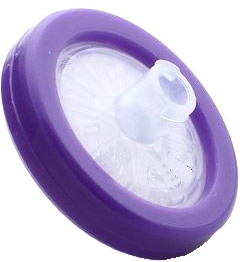 |
13mm DiameterSuitable for most applications Filtration area 1.09cm2 Maximum filtration volume >10ml Maximum operating pressure 87psi (6.0 bar) at 20°C Sample volume <10ml Holdup volume <25µl |
 |
4mm DiameterSuitable for smaller volume applications Filtration area 0.1cm2 Maximum filtration volume <2ml Maximum operating pressure 75psi (5.0 bar) at 20°C Sample volume <2ml Holdup volume <8ul |
 |
Pore Sizes
Q-Fil Syringe Filters are available in 0.22µm and 0.45µm pore sizes, (other pore sizes are available on request). The 0.22µm filters remove the smallest particulates whilst the 0.45µm filters are designed to remove particulates which would be detrimental to most analytical columns.
Pre-filters have a glass microfiber membrane which is chemically inert and resists most solvents. Q-Fil glass microfiber pre-filters are recommended for removing large particulates from the sample and are ideal for dissolution tests.
Syringe Filters with Glass Microfiber Pre-Filter
|
|
|
|
|
|
Greyhound Q-Fil Membrane Filters
Q-Fil Membrane Filters set the new Quality standard for today’s analytical laboratories. Manufactured from the highest quality materials, Q-Fil Membrane Filters provide excellent chemical compatibility with acids, alcohols, bases, ethers, glycols, ketones and oils.
As a trusted name in the supply of chromatography consumables and certified reference standards, Greyhound also offers a comprehensive selection of top quality own brand products including Capillary columns HPLC columns, Syringe Filters, Consumables etc. This catalogue contains details of our range of Q-Fil Membrane Filters. Other product catalogues are available on request.
| These quality products are backed by the guaranteed reliability and technical support which has become synonymous with the name Greyhound. |
Membrane Filter Comparison Chart
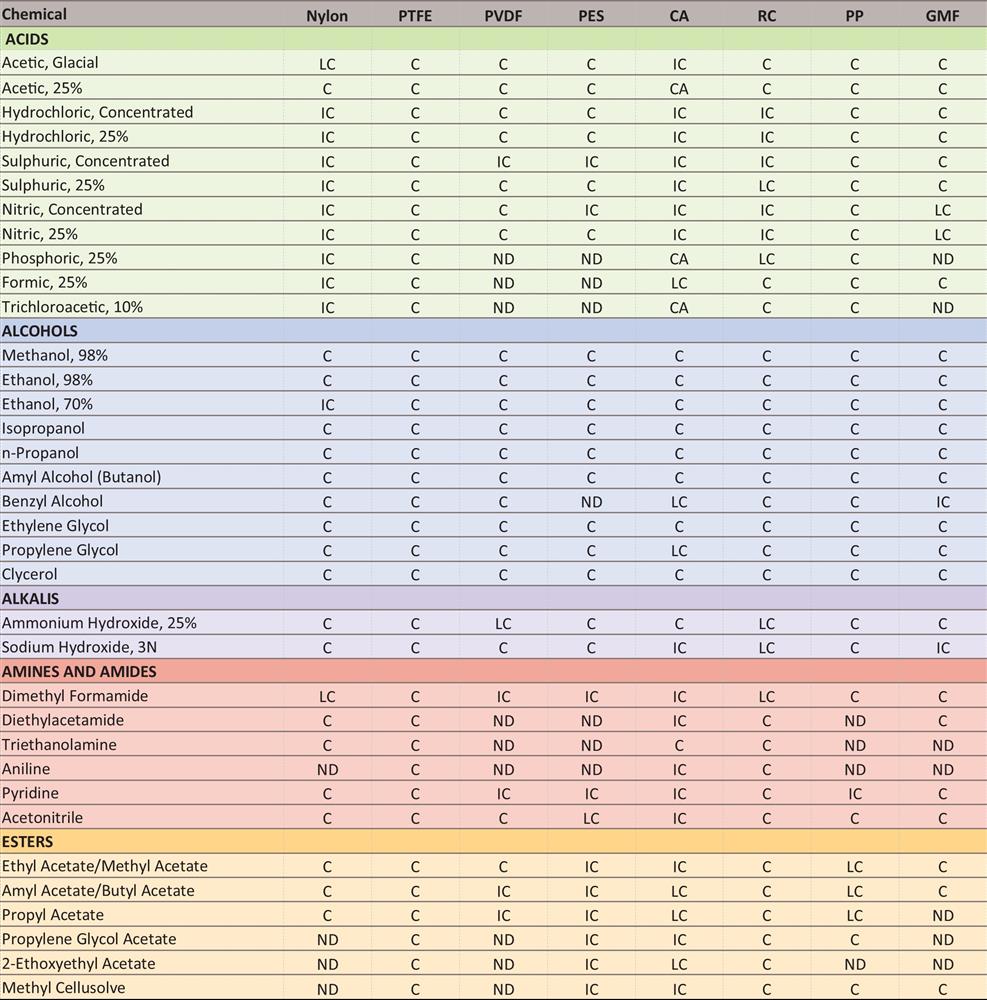
![Q-Fil Membrane Filters Comparison Chart [2] Image](/Content/Images/uploaded/images/Greyhound/Q-Fil Membrane Filters Comparison Chart 2.jpg)
|
NYLON Features:
Not suitable for use with strong acids or bases, halogenated hydrocarbons or protein Special discounts are available for call-off and bulk orders, please enquire. Multiple Pore Sizes and Diameters Available. |
 |
|
PTFE Hydrophobic Features:
|
 |
|
PTFE HydrophilicFeatures:
|
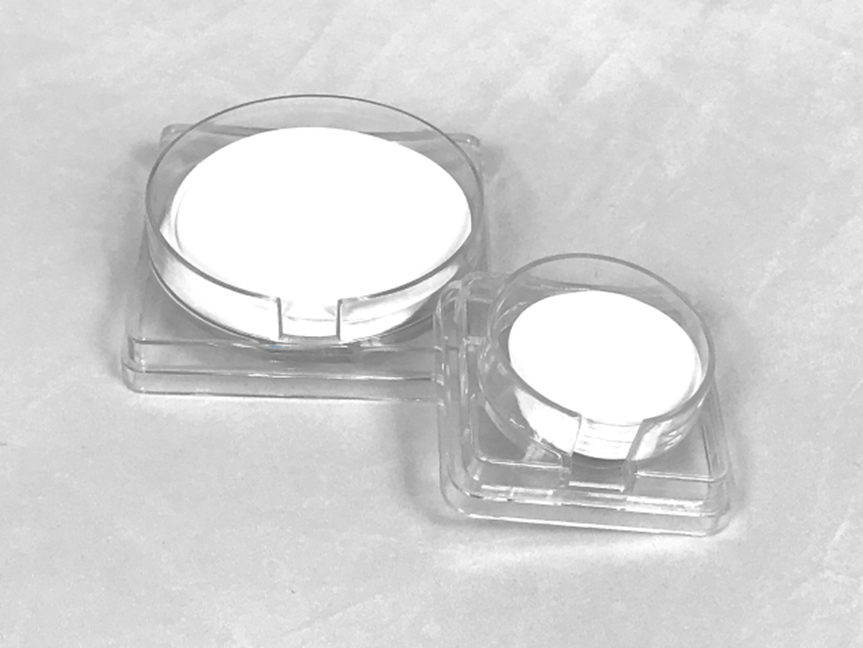 |
|
CELLULOSE NITRATE Features:
|
 |
|
CELLULOSE ACETATE Features:
culture media filtration and sensitive biological samples
lower than PVDF and PES membranes
Multiple Pore Sizes and Diameters available. |
|
PVDF (Hydrophobic) Features:
|
|
MIXED CELLULOSE ESTERS - Gridded Features: Gridded MCE membranes are unsupported natural hydrophilic filters which have clearly defined grid lines. The special ink used is non-toxic and completely free from bacterial growth inhibitors. Composed of cellulose acetate and cellulose nitrate, they are one of the most widely used membranes in analytic and research applications. The white gridded disks are specially designed for the recovery and retention of E.Coli bacteria in water/waste water analysis as well as other microbiological tests. The black gridded disks assist with manual counting procedures and provide enhanced contrast between residue or cell colours and the filter without having to counter stain the membrane.
|
 |
|
Features
|
Applications
|
|
POLYETHERSULFONE Features:
|
|
POLYPROPYLENE Features:
|
|
GLASS FIBER Features:
|
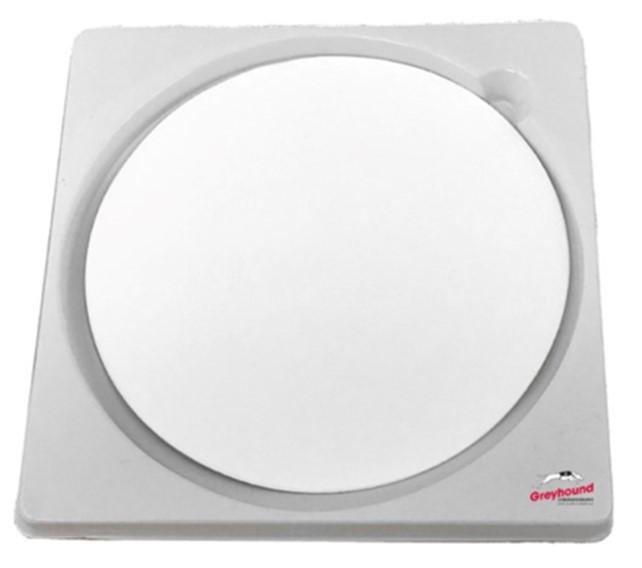 |
|
All Greyhound Vacuum Filtration Devices are made of stainless steel which is suitable for filtration, especially in the microbiological field.
|
 |
|
|
Greyhound Solvent Filtration Apparatus are used for the filtration of HPLC mobile phases, to remove particulate and microbiological contaminants. Manufactured of durable borosilicate glass for use with aqueous, organic or corrosive liquids. Can be sterilised in an autoclave at 121°C. The base design has an integral vacuum connection located above the filtrate drip to prevent contamination of the vacuum line with droplets. Unit consists of a funnel, coarse porosity fritted glass filter support base with integral vacuum connection and a flask with inner joint. An aluminium clamp connects the funnel and support base.
|




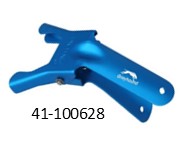
|
CONTACT US
Tel: +44 (0) 151 649 4000
Email: marketing@greyhoundchrom.com
FOLLOW US
YOU MAY ALSO BE INTERESTED IN OUR NEWSLETTER
About The Author
Susan Massie, Sales & Marketing Director, Greyhound Chromatography and Allied Chemicals Email: sue@greyhoundchrom.com
Susan Massie is the Sales & Marketing Director for Greyhound Chromatography and Allied Chemicals, affectionately known as 'Greyhound' in our scientific community. Greyhound was founded by Susan's husband Paul Massie almost 40 years ago, Susan hasn't been in the business for all of that time but has been involved with Greyhound for over 17 years. Greyhound continues to grow, expanding into new markets and taking on the challenges of our ever changing environment. It's heartwarming to witness the world waking up to the fact that we are damaging our planet on a daily basis. Every action we take has a direct effect on our planet and the world we leave behind for future generations. Susan is passionate about climate change and is happy to work in an industry that can have a direct effect on reducing the impact of our actions on the environment. All of the team at Greyhound take our responsibilities very seriously, the products that we supply are used by the world's leading scientists and chemists as they endeavour to monitor and repair the environment. All is not lost, if we all take responsibility for our actions, from reducing our waste and reusing or recycling our material collateral we can make a difference. The internet is full of useful advice and guidance, Susan is proud to contribute to that wealth of knowledge whenever she can.
Greyhound prides itself on personal service which provides prompt, efficient, cost-effective, safe delivery of all products. Greyhound provides technical advice and distribution of Certified Reference Standards and Materials, Laboratory Consumables, Solvents and Reagents across all scientific disciplines. Greyhound Chromatography offers over 1 Million products from its UK warehouse. The team at Greyhound are proud to support the work of the world's leading scientists and chemists as they challenge the abuse of our planet and try to make a difference to the world we leave behind for our ancestors.
You can view Susan's Linked In Profile here https://www.linkedin.com/in/susan-massie-79ab4121/












